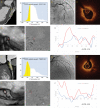Relationship of OCT-defined plaque characteristics with CCTA-derived coronary inflammation and CMR-derived global coronary flow reserve in patients with acute coronary syndrome
- PMID: 37228044
- PMCID: PMC10212089
- DOI: 10.1371/journal.pone.0286196
Relationship of OCT-defined plaque characteristics with CCTA-derived coronary inflammation and CMR-derived global coronary flow reserve in patients with acute coronary syndrome
Abstract
Background: The relationship of layered plaque detected by optical coherence tomography (OCT) with coronary inflammation and coronary flow reserve (CFR) remains elusive. We aimed to investigate the association of OCT-defined layered plaque with pericoronary adipose tissue (PCAT) inflammation assessed by coronary computed tomography angiography (CCTA) and global (G)-CFR assessed by cardiac magnetic resonance imaging (CMR) in patients with acute coronary syndrome (ACS).
Methods: We retrospectively investigated 88 patients with first ACS who underwent preprocedural CCTA, OCT imaging of the culprit lesion prior to primary/urgent percutaneous coronary intervention (PCI), and postprocedural CMR. All patients were divided into two groups according to the presence and absence of OCT-defined layered plaque at the culprit lesion. Coronary inflammation was assessed by the mean value of PCAT attenuation (-190 to -30 HU) of the three major coronary vessels. G-CFR was obtained by quantifying absolute coronary sinus flow at rest and during maximum hyperemia. CCTA and CMR findings were compared between the groups.
Results: In a total of 88 patients, layered plaque was detected in 51 patients (58.0%). The patients with layered plaque had higher three-vessel-PCAT attenuation value (-68.58 ± 6.41 vs. -71.60 ± 5.21 HU, P = 0.021) and culprit vessel-PCAT attenuation value (-67.69 ± 7.76 vs. -72.07 ± 6.57 HU, P = 0.007) than those with non-layered plaque. The patients with layered plaque had lower G-CFR value (median, 2.26 [interquartile range, 1.78, 2.89] vs. 3.06 [2.41, 3.90], P = 0.003) than those with non-layered plaque.
Conclusions: The presence of OCT-defined layered plaque at the culprit lesion was associated with high PCAT attenuation and low G-CFR after primary/urgent PCI in patients with ACS. OCT assessment of culprit plaque morphology and detection of layered plaque may help identify increased pericoronary inflammation and impaired CFR, potentially providing the risk stratification in patients with ACS and residual microvascular dysfunction after PCI.
Copyright: © 2023 Sugiyama et al. This is an open access article distributed under the terms of the Creative Commons Attribution License, which permits unrestricted use, distribution, and reproduction in any medium, provided the original author and source are credited.
Conflict of interest statement
The authors have declared that no competing interests exist.
Figures



Similar articles
-
Peri-coronary adipose tissue attenuation and its association with plaque vulnerability and clinical outcomes in coronary artery disease using combined CCTA and OCT.Sci Rep. 2025 May 13;15(1):16520. doi: 10.1038/s41598-025-00023-4. Sci Rep. 2025. PMID: 40360624 Free PMC article.
-
Pre-percutaneous Coronary Intervention Pericoronary Adipose Tissue Attenuation Evaluated by Computed Tomography Predicts Global Coronary Flow Reserve After Urgent Revascularization in Patients With Non-ST-Segment-Elevation Acute Coronary Syndrome.J Am Heart Assoc. 2020 Sep;9(17):e016504. doi: 10.1161/JAHA.120.016504. Epub 2020 Aug 28. J Am Heart Assoc. 2020. PMID: 32856503 Free PMC article.
-
Plaque Rupture, Compared With Plaque Erosion, Is Associated With a Higher Level of Pancoronary Inflammation.JACC Cardiovasc Imaging. 2022 May;15(5):828-839. doi: 10.1016/j.jcmg.2021.10.014. Epub 2021 Nov 8. JACC Cardiovasc Imaging. 2022. PMID: 34876381 Clinical Trial.
-
Computed tomography and nuclear medicine for the assessment of coronary inflammation: clinical applications and perspectives.J Cardiovasc Med (Hagerstown). 2023 Apr 1;24(Suppl 1):e67-e76. doi: 10.2459/JCM.0000000000001433. J Cardiovasc Med (Hagerstown). 2023. PMID: 37052223 Review.
-
Epicardial and Pericoronary Adipose Tissue, Coronary Inflammation, and Acute Coronary Syndromes.J Clin Med. 2023 Nov 21;12(23):7212. doi: 10.3390/jcm12237212. J Clin Med. 2023. PMID: 38068263 Free PMC article. Review.
Cited by
-
Relationship between peri-coronary inflammation and coronary vascular function in patients with suspected coronary artery disease.Front Cardiovasc Med. 2024 Feb 8;11:1303529. doi: 10.3389/fcvm.2024.1303529. eCollection 2024. Front Cardiovasc Med. 2024. PMID: 38390440 Free PMC article.
-
Coronary plaque healing: a safety net or a hazard indicator?J Thromb Thrombolysis. 2025 Jul 18. doi: 10.1007/s11239-025-03152-9. Online ahead of print. J Thromb Thrombolysis. 2025. PMID: 40681803 Review.
-
Layered plaque is associated with high levels of vascular inflammation and vulnerability in patients with stable angina pectoris.J Thromb Thrombolysis. 2024 Aug;57(6):880-887. doi: 10.1007/s11239-024-02982-3. Epub 2024 Apr 22. J Thromb Thrombolysis. 2024. PMID: 38649561
-
Identifying the vulnerable patient: pericoronary Adipose tissue attenuation on computed tomography.J Thromb Thrombolysis. 2024 Aug;57(6):877-879. doi: 10.1007/s11239-024-03014-w. Epub 2024 Jul 16. J Thromb Thrombolysis. 2024. PMID: 39014274 No abstract available.
References
-
- Shimokado A, Matsuo Y, Kubo T, Nishiguchi T, Taruya A, Teraguchi I, et al.. In vivo optical coherence tomography imaging and histopathology of healed coronary plaques. Atherosclerosis. 2018;275:35–42. - PubMed
-
- Oikonomou EK, Marwan M, Desai MY, Mancio J, Alashi A, Hutt Centeno E, et al.. Non-invasive detection of coronary inflammation using computed tomography and prediction of residual cardiovascular risk (the CRISP CT study): a post-hoc analysis of prospective outcome data. Lancet. 2018;392(10151):929–39. doi: 10.1016/S0140-6736(18)31114-0 - DOI - PMC - PubMed
MeSH terms
LinkOut - more resources
Full Text Sources
Medical
Miscellaneous

